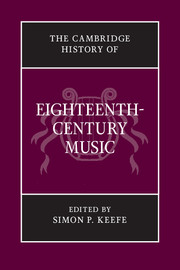Book contents
- Frontmatter
- PRELUDE
- PART I MUSIC FOR THE CHURCH
- INTERLUDE
- PART II MUSIC FOR THE THEATRE
- INTERLUDE
- PART III MUSIC FOR THE SALON AND CONCERT ROOM
- 16 Keyboard music from Couperin to early Beethoven
- 17 The serenata in the eighteenth century
- 18 Private music in public spheres: chamber cantata and song
- 19 Handel and English oratorio
- 20 The overture-suite, concerto grosso, ripieno concerto and Harmoniemusik in the eighteenth century
- 21 Concerto of the individual
- 22 Eighteenth-century symphonies: an unfinished dialogue
- 23 The string quartet
- POSTLUDE
- Appendix I Chronology
- Appendix II Institutions in major European cities
- Appendix III Personalia
- Index
- References
17 - The serenata in the eighteenth century
from PART III - MUSIC FOR THE SALON AND CONCERT ROOM
Published online by Cambridge University Press: 28 March 2011
- Frontmatter
- PRELUDE
- PART I MUSIC FOR THE CHURCH
- INTERLUDE
- PART II MUSIC FOR THE THEATRE
- INTERLUDE
- PART III MUSIC FOR THE SALON AND CONCERT ROOM
- 16 Keyboard music from Couperin to early Beethoven
- 17 The serenata in the eighteenth century
- 18 Private music in public spheres: chamber cantata and song
- 19 Handel and English oratorio
- 20 The overture-suite, concerto grosso, ripieno concerto and Harmoniemusik in the eighteenth century
- 21 Concerto of the individual
- 22 Eighteenth-century symphonies: an unfinished dialogue
- 23 The string quartet
- POSTLUDE
- Appendix I Chronology
- Appendix II Institutions in major European cities
- Appendix III Personalia
- Index
- References
Summary
The eighteenth-century serenata has long remained a conundrum – difficult to define in its many permutations and to distinguish from other genres, or seen as somewhat peripheral because of its ephemeral, occasional nature, often leaving little or no trace for historians. Yet the challenges it presents have encouraged a rich collection of scholarly investigation, mostly on a local level, the best perspective from which to interpret the serenata as musical practice, as performance event, and as a refractor of eighteenth-century history. In many respects, divergences abound: the serenata in Italy influenced those produced in Italianate court societies in Vienna and in northern Europe; in England, however, analogous serenata events acquired different local customs as was also the case in locations such as Spain and Portugal. Variability was a feature of this genre, whose function and conditions for performance changed according to context and occasion.
The similarities found among serenatas of different locales teach important lessons. In a very general sense, the serenata was a musical performance commemorating an event, or presented in someone’s honour. It was most typically an open-air performance, often done at night, but other modes of presentation also existed. In the eighteenth century, the serenata frequently functioned as both musical form and event, serving political rituals marked by symbolic modes of representation. Marking occasions such as royal births, marriages, military victories, or recoveries from illness, the serenata offered patrons an opportunity for social display and image-building.
- Type
- Chapter
- Information
- The Cambridge History of Eighteenth-Century Music , pp. 492 - 512Publisher: Cambridge University PressPrint publication year: 2009
References
- 1
- Cited by

